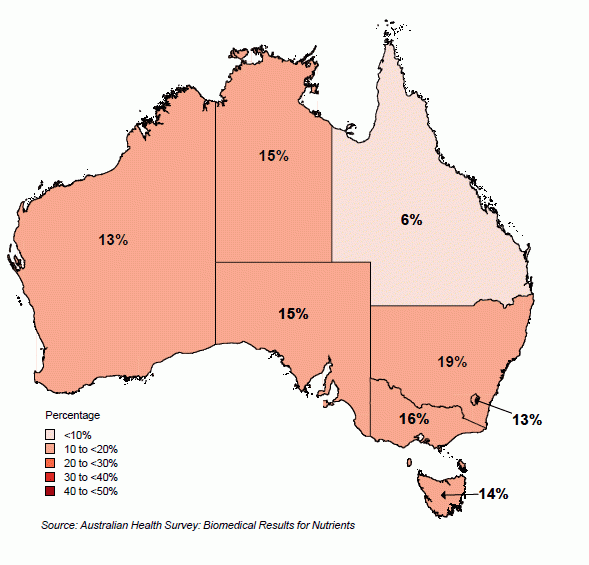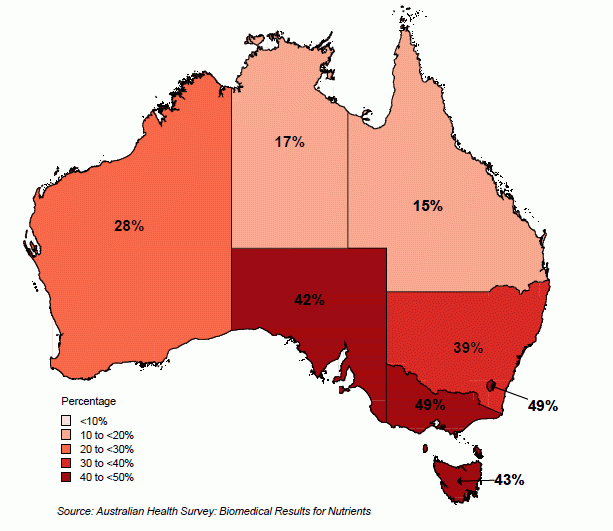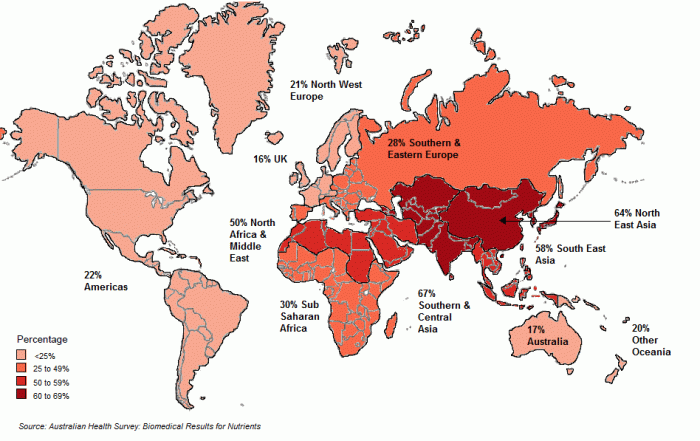Introduction
Vitamin D is essential for the body to absorb calcium effectively, which is important for bone health and muscle function, and for preventing conditions such as osteoporosis. The main source of Vitamin D is exposure to sunlight, although small amounts can be obtained through some foods, such as fatty fish and fortified margarine and milk.¹
The main consequence of severe Vitamin D deficiency is rickets in children and osteopenia (fragile bones) in older people.¹ There is some evidence to suggest that low Vitamin D levels could also be a risk factor for other chronic conditions, including heart disease, cancer and kidney disease, but more research is needed to better understand these links.² ³
This article presents information on Vitamin D levels across Australia and looks at how they vary for different population groups.
Measuring Vitamin D
In the ABS National Health Measures Survey (NHMS), Vitamin D levels were measured via a blood test, which measures Vitamin D obtained from both food and sunlight.¹
The NHMS used the Liquid Chromatography Mass Spectrometry (LCMS) method to assess Vitamin D status. This method has the highest sensitivity and specificity for measurement of Vitamin D and is considered by many to be the gold standard Vitamin D assay.⁴
Given the expensive equipment required for the LCMS method and the lack of standardisation in measurement across laboratories, the LCMS method is not yet widely used in Australia³ and standardised test cut-offs are yet to be developed.
In the NHMS, the levels recommended in a recent Australian position statement on Vitamin D² have been applied to determine Vitamin D deficiency. These cut-offs are:
- Mild deficiency: 30 – 49 nmol/L
- Moderate deficiency: 13* – 29 nmol/L
- Severe deficiency: <13* nmol/L
- Total deficiency: <50 nmol/L
- Adequate levels: ≥50 nmol/L#
* Note that the cut-off recommended in the position statement is <12.5 nmol/L, but the NHMS is unable to output against this cut-off as the Vitamin D data is only available in whole numbers.
# Note that the position statement states that levels may need to be 10 to 20 nmol/L higher at the end of summer, to allow for seasonal decrease.
Do Australians get enough Vitamin D?
The majority of Australian adults had sufficient levels (>50 nmol/L) of Vitamin D in 2011–12. Just under one in four (23%), or 4 million adults, had a Vitamin D deficiency, which comprised 17% with a mild deficiency, 6% with a moderate deficiency and less than 1% with a severe deficiency. Overall, rates of Vitamin D deficiency were very similar for both men and women.
How many people were taking Vitamin D supplements?
The National Health Survey (NHS) component of the Australian Health Survey asked all people (regardless of whether they went on to participate in the biomedical component) about the different types of supplements they were taking, including Vitamin D.
The results showed that one in twenty Australian adults (5%) were taking Vitamin D supplements in 2011–12. As expected, those who took Vitamin D supplements had lower levels of Vitamin D deficiency than those who did not take supplements (7% compared with 23%). Interestingly, among those with relatively high Vitamin D levels of greater than or equal to 100 nmol/L, only around one in ten were taking Vitamin D supplements.
As shown in the graph below, supplementation use was much more common among older people, especially women. This could be partly due to the natural loss of bone density in women after menopause, which places them at higher risk of osteoporosis.⁵
Are older people more likely than younger people to be Vitamin D deficient?
The NHMS showed that older adults were less likely than younger adults to be Vitamin D deficient, but at the same time Vitamin D supplements were more commonly used among older people. Vitamin D deficiency ranged from 31% of those aged 18–34 years to 15% of those aged 65–74 before increasing again to 20% for those aged 75 years and over.
Children, on the other hand, had relatively low levels of Vitamin D deficiency in 2011–12. Around 15% of children aged 12 to 17 years were deficient, with similar rates for boys (15%) and girls (16%).
How do Vitamin D levels vary by season and region?
Data from the NHMS was collected throughout all 12 months of the year (see the Methodology for more information). Month of collection was used to analyse the seasonal effects of Vitamin D deficiency in the NHMS. For example, Vitamin D levels for those who had their blood samples taken in December, January or February (summer) were compared with those who had them taken in June, July or August (winter).
As expected, Vitamin D levels varied considerably by season, with rates of deficiency being much lower in summer (14%) and much higher in winter (36%). In summer, deficiency levels were relatively low across all the States and Territories, ranging from 6% in Queensland to 19% in New South Wales.
Vitamin D deficiency in summer by state and territory, 2011-12
Image

Description
In winter, rates of Vitamin D deficiency were particularly high for those living in the south eastern states of Australia, such as Victoria and ACT, where nearly one in every two people (49%) were Vitamin D deficient in winter compared with only 16% and 13% respectively in summer. By comparison, Vitamin D deficiency remained relatively low in winter for those in Queensland and the Northern Territory.
Vitamin D deficiency in winter by state and territory, 2011-12
Image

Description
The NHS showed that use of Vitamin D supplements was most common among those living in Tasmania (9%) and Victoria (8%) and lowest in Queensland (2%) and the Northern Territory (less than 1%).
Differences were also seen across remoteness areas, with Vitamin D deficiency being more common among those living in Major cities (27%) compared with those living in Inner regional (16%), Outer regional (13%) and Remote areas (9%).
Which population groups are at high risk of Vitamin D deficiency?
The prevalence of Vitamin D deficiency varies among the Australian population, with the groups at greatest risk typically being those with limited sun exposure.²
The Australian position statement on Vitamin D² highlights that Vitamin D deficiency may be more prevalent among those with darker skin or who cover their skin for cultural or religious reasons. The NHMS showed that Vitamin D deficiency was much more common among those born in Southern and Central Asia (67%) as well as North East Asia (64%), South East Asia (58%) and North Africa and the Middle East (50%). This was despite the fact that that those born in Southern and Central Asia and North Africa and the Middle East had relatively high rates of Vitamin D supplement use (14% and 15% respectively compared with 4% of those born in Australia). Rates of deficiency also remained very high even during the summer months, with 60% of people born in Southern and Central Asia and 50% of people born in South East Asia still being deficient in December to February.
Australian resident population: Vitamin D deficiency by region of birth, 2011-12
Image

Description
Vitamin D levels were also associated with the type of work people do, with those employed in occupations based mostly inside, such as sales workers (28%) and professionals (26%) being more likely to have a Vitamin D deficiency than those working in jobs based mostly outside, such as machinery operators and drivers (18%). However, these vocational differences were much less pronounced during the summer months.
The Australian position statement² also identifies those with a disability, especially those who are housebound or in residential care, are another group at risk of Vitamin D deficiency. Interestingly, in the NHMS, there was no significant difference in Vitamin D levels between those with a profound or severe disability compared with those with no disability or long-term health condition in 2011–12. This could be due in part to the scope of the survey, which excludes non private dwellings. It could also be the result of people with a profound/severe disability being nearly three times as likely as those without a disability to be taking Vitamin D supplements (11% compared with 4%).
Is Vitamin D associated with health risk factors like obesity, smoking and physical activity?
While it is generally thought that obese people are at greater risk of Vitamin D deficiency (because excess body fat can interfere with the absorption of Vitamin D),² this relationship was not evident in the NHMS. Levels of Vitamin D deficiency were similar for those adults of normal weight/underweight and those who were obese (26% compared with 25%). Vitamin D supplements are unlikely to be a contributing factor here, as the NHS showed that supplement use was similar across all BMI categories.
There was, however, an association with smoking. In 2011–12, current smokers were more likely than non-smokers to have a Vitamin D deficiency (28% compared with 23%).
As expected, levels of physical activity were also associated with Vitamin D in 2011–12. People who undertook high levels of physical activity for fitness, recreation, sport or walking for transport were less likely than those with low levels of activity or who were sedentary to have a Vitamin D deficiency (15% compared with 26%).
What about chronic health conditions?
There is some evidence to suggest that low Vitamin D levels are associated with increased risk of some chronic health conditions, including heart disease, cancer and kidney disease, although these links are yet to be clearly established.² ³
In 2011–12, people with a Vitamin D deficiency were more likely than those with adequate Vitamin D to have abnormal levels of HDL (good) cholesterol (28% compared with 22%) and to have diabetes, as measured by HbA1c (8% compared with 5%). It's important to note, however, that the cause and effect of these relationships cannot be determined from this information.
There was no significant relationship between Vitamin D and the other cardiovascular biomarkers, including total cholesterol and triglycerides, nor with self-reported levels of heart disease. There was also no clear association between Vitamin D and the biomarkers for kidney disease or liver disease.
There was, however, a higher proportion of Vitamin D supplement use among those with self-reported diabetes (12%) heart disease (10%) and osteoporosis (18%) compared with all adults (5%).